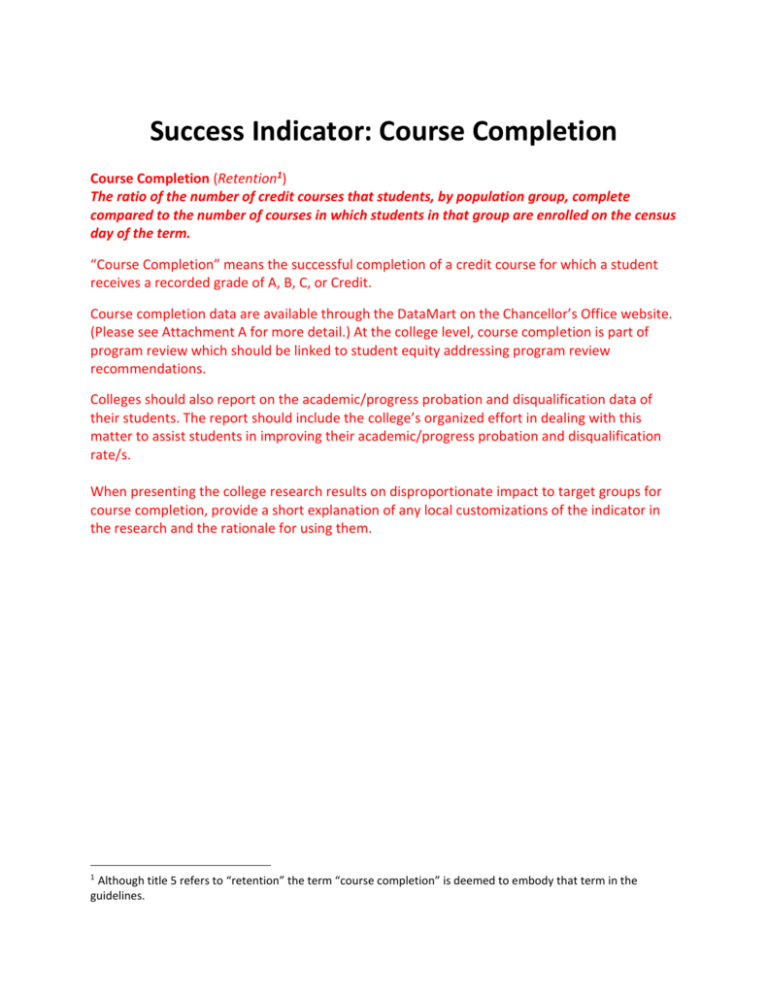Course Completion (Retention 1 )
advertisement

Success Indicator: Course Completion Course Completion (Retention1) The ratio of the number of credit courses that students, by population group, complete compared to the number of courses in which students in that group are enrolled on the census day of the term. “Course Completion” means the successful completion of a credit course for which a student receives a recorded grade of A, B, C, or Credit. Course completion data are available through the DataMart on the Chancellor’s Office website. (Please see Attachment A for more detail.) At the college level, course completion is part of program review which should be linked to student equity addressing program review recommendations. Colleges should also report on the academic/progress probation and disqualification data of their students. The report should include the college’s organized effort in dealing with this matter to assist students in improving their academic/progress probation and disqualification rate/s. When presenting the college research results on disproportionate impact to target groups for course completion, provide a short explanation of any local customizations of the indicator in the research and the rationale for using them. 1 Although title 5 refers to “retention” the term “course completion” is deemed to embody that term in the guidelines. CAMPUS-BASED RESEARCH: COURSE COMPLETION B. COURSE COMPLETION. The ratio of the number of credit courses that students, by population group, complete compared to the number of courses in which students in that group are enrolled on the census day of the term. Calculate course completion rates by dividing: Course Completion by Gender and Course Completion by Ethnicity Course Completion by Low Income by Face to Face Course Completion by Low Income by DE Course Completion by DSPS Course Completion by Veterans Course Completion by Foster Youth *The all student average is proposed as the comparison point for all groups. Therefore, this rate would be written in all of the orange boxes and used to calculate the equity gap for each group (the last column on the right). **Calculated by subtracting the average rate of courses passed from the student group’s rate of courses passed – paying close attention to the +/- designation. Note: Because it would be confusing for positive values to represent a gap and negative values to represent equal or higher success, the worksheet switches the order of the operation. Where a student group’s success rate is lower than the average group’s rate, a negative value will result. **’-14’ is calculated by subtracting 71 (the average student success rate) from 57 (the success rate of the example group). The ‘-’ is added to signify that the example group’s success rate is lower than the all student average. A ‘+‘ would indicate that a given group has greater success. Prompt to guide analysis (as applicable): Which three student groups are experiencing the greatest gaps – and how large are these gaps (in percentage points)? For DE: African American For Face to Face: African American For General Course Completion: Foster Youth For these three student groups (as applicable) calculate the number of students ‘lost’, which is also the number of students who, if they had succeeded, would have closed the equity gap: 1 Equity Gap --Largest Gap Second Largest Third Largest Fourth Largest Student Group Example Group African American (DE) Pacific Islander (DE) Foster Youth African American (Face to Face) Gap in comparison to the Average, Expressed as Percentage 2 Percentage expressed as decimal 25% becomes .25 3 4 Multiply the # of courses students enrolled in & were present in on census day in base year = Number of Students “Lost” 14% .14 x 2567 = 359 18.41% .1841 x 1797 = 331 16.26% .1626 x 40 = 7 11.16% .1116 x 2,349 = 262 10.39% .1039 x 13,945 = 1449 GOALS, ACTIVITIES, FUNDING AND EVALUATION: COURSE COMPLETION GOAL B. The goal is to improve course completion for the following target populations identified in the college research as experiencing a disproportionate impact: Target Population(s) Current gap, year Goal* Goal Year Example Group -14, 2014 Gap no > -6 2020 African American (DE course comp) -18, 2014 Gap no > than -9 2024 Foster Youth (general course comp) -11, 2014 Gap no > than -5 2024 African American (face to face course -10, 2014 Gap no > than -10 2024 comp) *Expressed as either a percentage or number. **Benchmark goals are to be decided by the institution. If the target population(s) are different from the populations with the three greatest gaps (as outlined on the previous page) provide an explanation: Since the numbers for the Pacific Islander group is so small, the college has decided that we would be able to have a much bigger impact if we focused on the African American (DE), Foster Youth, and African American (face to face) students. ACTIVITIES: B. COURSE COMPLETION B.1 Activity Type(s) (Mark an X in all that apply. See Student Equity Expenditure Guidelines for more information.): o NEEDS ASSESSMENT - Survey all students in DE courses (collecting demographics) to determine areas in which they need more support and share with faculty, staff and administrators to create a plan to address course completion gap for African American students taking DE courses. X Outreach Student Services or other Categorical Program Research and Evaluation X Target Student Group(s) & # of Each Affected*: ID Target Group(s) B.1 African American (DE) Student Equity Coordination/Planning Curriculum/Course Development or Adaptation Professional Development # of Students Affected 1797 Instructional Support Activities Direct Student Support * For example, Veterans – 250, Af. Americans – 8,889, Hispanics 10,000, etc. Activity Implementation Plan Describe the activity. If the proposed activity is additional research, share any additional data that has been or will be collected to better understand the nature of the target populations’ gaps and the actions that will be taken to reach the goal. (For example: colleges may plan to collect disaggregated data to identify the courses in which the target groups are experiencing the least success; observations may be conducted in the classrooms in which target groups are experiencing the least success; or interviews with students from the target group could be conducted to better understand what barriers emerged in the identified classrooms.) If the activity is a new intervention to improve outcomes, include references to any literature or research demonstrating its effectiveness. Include projected start and end dates for the activity, and the budget allocated to the activity, including—student equity and other funding**). If augmenting an existing program or activity, provide an overview of program history, date of implementation, relevant data on impact from research and evaluation, timeline and description of activity to be implemented with student equity funding, and budget including expenditures of student equity funding and other program funding**, including a description of how student equity funds will not be supplanting other district funds. Planned expenditures should be listed here as well as in the Student Equity Plan Summary Budget spreadsheet. Activity plan: 1) Identify committee/taskforce to focus on DE course completion. 2) Group to develop survey. 3) Group to work with administrators/staff to administer survey and collect data. 4) Group to analyze data and provide an analysis of the results and recommendations to the Education Committee. ID Planned Start and End Date(s) B.1 Spring 2016 Student Equity Funds Surveymonkey Site License - $? Other Funds** ** Indicate categorical program or other fund source and amount, for example: Basic Skills Initiative - $10,000, EOPS – $9,000, Financial Aid - $13,000, General Fund $24,000, etc. Link to Goal Provide a brief explanation of how this activity will help achieve the goal(s) described above. This activity will provide the college with more information into the specific needs of African American students taking DE courses. It will also identify if the needs for African American students are different that the general student population so that we can better serve them. Evaluation Data that will be collected—both quantitative and qualitative—to measure impact of activity on the goal. Pre-Survey the knowledge base of faculty, staff and administrators on DE student needs before we conduct the research. Provide workshops and summary of findings to the college community. (Perhaps a flex day student panel) Post-Survey the knowledge base of the faculty, staff and administrators on DE students needs. A timeline of / frequency of data collection and review. Pre-survey in Spring 2016, Post survey after the workshop presentation (Fall 2016 flex) B.2 Activity Type(s) (Mark an X in all that apply. See Student Equity Expenditure Guidelines for more information.): Outreach Student Services or other Categorical Program Research and Evaluation Target Student Group(s) & # of Each Affected*: Student Equity Coordination/Planning Curriculum/Course Development or Adaptation Professional Development Instructional Support Activities Direct Student Support ID B.2 Target Group # of Students Affected * For example, Veterans – 250, Af. Americans – 8,889, Hispanics 10,000, etc. Activity Implementation Plan Describe the activity. If it is a new intervention, include references to any literature or research demonstrating its effectiveness. Include start and end dates for the activity, and the budget allocated to the activity, including—student equity and other funding**). If augmenting an existing program or activity, provide an overview of program history, date of implementation, relevant data on impact from research and evaluation, timeline and description of activity to be implemented with student equity funding, and budget including expenditures of student equity funding and other program funding**, including a description of how student equity funds will not be supplanting other district funds. Planned expenditures should be listed here as well as in the Student Equity Plan Summary Budget spreadsheet. ID Timeline(s) Student Equity Funds Other Funds** B.2 ** Indicate categorical program or other fund source and amount, for example: Basic Skills Initiative - $10,000, EOPS – $9,000, Financial Aid - $13,000, General Fund $24,000, etc. Link to Goal Provide a brief explanation of how this activity will help achieve the goal(s) described above. Evaluation Data that will be collected—both quantitative and qualitative—to measure impact of activity on the goal. A timeline of / frequency of data collection and review. B.3 …, etc.




